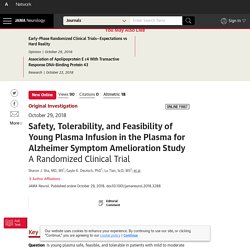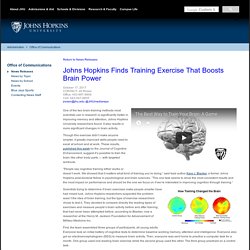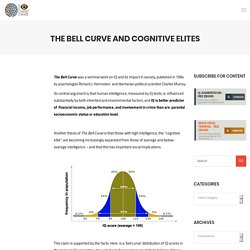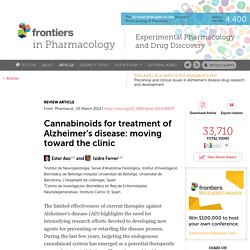

Jamanetwork. Question Is young plasma safe, feasible, and tolerable in patients with mild to moderate Alzheimer disease dementia?

Findings This randomized clinical trial consisted of a double-blind crossover group of 9 patients and an open-label group of 9 patients. Patients with mild to moderate Alzheimer disease dementia were able to tolerate 4 weekly infusions of young plasma. Meaning Safe and well tolerated in a small sample of patients with mild to moderate Alzheimer disease dementia, young plasma infusions warrant further analysis in a larger study using a double-blinded design with a placebo control. Importance Young mouse plasma restores memory in aged mice, but, to our knowledge, the effects are unknown in patients with Alzheimer disease (AD).
Objective To assess the safety, tolerability, and feasibility of infusions of young fresh frozen plasma (yFFP) from donors age 18 to 30 years in patients with AD. N-back task-working memory training. Johns Hopkins Finds Training Exercise That Boosts Brain Power. October 17, 2017 CONTACT: Jill Rosen Office: 443-997-9906 Cell: 443-547-8805jrosen@jhu.edu @JHUmediareps One of the two brain-training methods most scientists use in research is significantly better in improving memory and attention, Johns Hopkins University researchers found.

It also results in more significant changes in brain activity. The Bell Curve and Cognitive Elites. The Bell Curve was a seminal work on IQ and its impact in society, published in 1994 by psychologist Richard J.

Herrnstein and libertarian political scientist Charles Murray. Its central argument is that human intelligence, measured by IQ tests, is influenced substantially by both inherited and environmental factors, and IQ is better predictor of financial income, job performance, and involvement in crime than are parental socioeconomic status or education level. Another thesis of The Bell Curve is that those with high intelligence, the “cognitive elite”, are becoming increasingly separated from those of average and below-average intelligence – and that this has important social implications.
This claim is supported by the facts. Your college major is a pretty good indication of how smart you are. Do students who choose to major in different fields have different academic aptitudes?

This question is worth investigating for many reasons, including an understanding of what fields top students choose to pursue, the diversity of talent across various fields, and how this might reflect upon the majors and occupations a culture values. In order to explore this, I used five different measures of US students’ academic aptitude, which span 1946 to 2014, and discovered that the rank order of cognitive skills of various majors and degree holders has remained remarkably constant for the last seven decades. An important caveat: The data presented looks only at group averages and does not speak to the aptitude of specific individuals. Obviously there are people with high academic aptitude in every major and there can be larger aptitude differences between entire schools—for example the University of Chicago and a local community college—than between majors within a school.
Inhalational Alzheimer's, ReCODE protocol and Mold Illlness with Dr. Dale Bredesen. The End Of Alzheimer's Disease with Dr Dale Bredesen & Dr Daniel Amen. Dr. Dale Bredesen. The global burden of dementia is staggering, and unfortunately on the rise.

Of the 318 million Americans currently living, 45 million will develop Alzheimer’s disease. There are 75 million Americans with ApoE4, the most important genetic risk factor for Alzheimer’s disease. It is expected that by 2050, there will be over 160,000,000 patients with Alzheimer’s disease globally. For women, Alzheimer’s is more common than breast cancer, as women make up over 65% of the patients and 60% of the caregivers. Reversing Alzheimer’s Disease- Dr. Dale Bredesen, MD. The Journal of Prevention of Alzheimer's Disease. NAC in Treatment of Alz. D. Vit D and Dementia. Dementia Rates Fall with Rising Lithium Levels in Water. Action Points Long-term increased lithium exposure in drinking water may be associated with a lower incidence of dementia.Note that although not proof of a causal relationship, the findings add to other indirect evidence of a beneficial effect of low-dose lithium on cognitive function.

Would adding lithium to the drinking water protect an aging population from dementia? Department of Psychology - Gary Wenk. Gold, P.E., Cahill, L., & Wenk, G.L. (2003) The lowdown on Ginkgo biloba.

Scientific American, April, 86-91. PDF Doody, R.S., Mintzer, J.E., Sano, M., Wenk, G.L. & Grossberg, G.T. (2003) Alzheimer's disease: Emerging noncholinergic treatments. Geriatrics, (Suppl) 3-11. Wenk, G.L. (2003) Neuropathologic changes in Alzheimer¹s Disease. Cannabinoids for treatment of Alzheimer’s disease: moving toward the clinic. Introduction Alzheimer is an age-dependent neurodegenerative process distinct from normal aging and characterized morphologically by the presence of senile plaques, mainly composed of different species of fibrillar β-amyloid (Aβ) produced by the cleavage of the Aβ precursor protein (APP) due to β- and γ-secretases, and by the presence of neurofibrillary tangles, mostly composed of various isoforms of hyper-phosphorylated and nitrated tau protein (Duyckaerts and Dickson, 2011; Ferrer, 2012).

One tendency of opinion proposes that Aβ triggers plaque formation, tau hyper-phosphorylation, and disease progression (Hardy, 2009). This may happens in a percentage of familial Alzheimer’s disease (AD) cases linked to mutations in genes encoding APP, and presenilin 1 and presenilin 2 which are enzymes involved in the cleavage of APP, or in Down syndrome (Bertram and Tanzi, 2011). The Endogenous Cannabinoid System. BardouetalHealth2012. NeurosciLett4802010. JNeuroinflam2012. Periodontal Disease Associated with Higher Risk of Dementia: Population-Based Cohort Study in Taiwan. Audio.
Mind. Mind & Brain News. May 19, 2017 — A new study has served to identify some genetic mutations that will help to improve the treatment of ... read more May 19, 2017 — Scientists have made an important step in understanding the organization of nerve cells embedded within the gut that control its function -- a discovery that could give insight into the origin of ... read more Scientists to Test Zika Virus on Brain Tumors May 19, 2017 — In a revolutionary first, scientists will test whether the Zika virus can destroy brain tumor cells, potentially leading to new treatments for one of the hardest to treat cancers. ... read more Female Faculty Face Strong Glass Ceiling in Male-Dominated University Environments, Study Concludes.

Neuroscience & Neurology - Topic. New cryopreservation procedure wins Brain Preservation Prize. (Left): Control rabbit brain, showing neuropil near the CA1 band in the hippocampus.

(Right): Vitrified rabbit brain, same location. Synapses, vesicles, and microfilaments are clear. Daily Marijuana Use Doesn’t Really Change Brains of Adults or Teens, Study Finds. Last year, the press and marijuana-legalization opponents gave a lot of attention to a study suggesting that daily marijuana causes abnormalities in the brain. New research, reportedly using better techniques, indicates that claim and other reports of cannabis-caused changes to brain structure simply aren't true.
The authors of the new study, "Daily Marijuana Use Is Not Associated with Brain Morphometric Measures in Adolescents or Adults," published in the latest edition of the Journal of Neuroscience, suggest that alcohol use was responsible for previous studies finding brain changes. An abstract of the study's findings was published last week on the Journal's website. It describes how scientists could not replicate recent research that claimed the use of cannabis "is associated with volumetric and shape differences in subcortical structures...
" Eating green leafy vegetables keeps mental abilities sharp. Something as easy as adding more spinach, kale, collards and mustard greens to your diet could help slow cognitive decline, according to new research. The study also examined the nutrients responsible for the effect, linking vitamin K consumption to slower cognitive decline for the first time. "Losing one's memory or cognitive abilities is one of the biggest fears for people as they get older," said Martha Clare Morris, Sc.D., assistant provost for community research at Rush University Medical Center and leader of the research team. "Since declining cognitive ability is central to Alzheimer's disease and dementias, increasing consumption of green leafy vegetables could offer a very simple, affordable and non-invasive way of potentially protecting your brain from Alzheimer's disease and dementia. " "Our study identified some very novel associations," said Morris, who will present the research at the American Society for Nutrition (ASN) Annual Meeting during Experimental Biology 2015.
New Alzheimer’s treatment fully restores memory function. Australian researchers have come up with a non-invasive ultrasound technology that clears the brain of neurotoxic amyloid plaques - structures that are responsible for memory loss and a decline in cognitive function in Alzheimer’s patients. If a person has Alzheimer’s disease, it’s usually the result of a build-up of two types of lesions - amyloid plaques, and neurofibrillary tangles.
Amyloid plaques sit between the neurons and end up as dense clusters of beta-amyloid molecules, a sticky type of protein that clumps together and forms plaques. Neurofibrillary tangles are found inside the neurons of the brain, and they’re caused by defective tau proteins that clump up into a thick, insoluble mass. This causes tiny filaments called microtubules to get all twisted, which disrupts the transportation of essential materials such as nutrients and organelles along them, just like when you twist up the vacuum cleaner tube.
Memory loss associated with Alzheimer's reversed for first time - Neuroscience Research Article. This is a temporary webpage created to handle heavy traffic to this article. Many of the normal features of the website have been stripped from this page to help reduce load times. Small trial from Buck Institute and UCLA succeeds using systems approach to memory disorders. PET scans reveal key details of Alzheimer’s protein growth in aging brains. New research led by scientists at UC Berkeley shows for the first time that PET scans can track the progressive stages of Alzheimer’s disease in cognitively normal adults, a key advance in the early diagnosis and staging of the neurodegenerative disorder. Dr. William Jagust shows how PET scans can help track the progression of Alzheimer’s disease.
(UC Berkeley video produced by Roxanne Makasdjian and Stephen McNally) Dose-Response Effects of Low-Level Light Therapy on Brain & Muscle. Brain care with Dr. Russell Blaylock. How Whole Turmeric Heals The Damaged Brain. Episode 79 - Phosphatidylserine: Extra Oomph, Even For Young Brains. Protect Your Brain With Antioxidants. Is This Your Brain on Smart Drugs? Nootropics. Nootropics - The Facts About "Smart Drugs" Sugar Harms Your Brain Health, Drives Alzheimer’s Epidemic. Young blood to be used in ultimate rejuvenation trial. Tiny magnetic coils may be safer than implanted electrodes for deep-brain stimulation. Spatial memory deficits in a mouse model of late-onset Alzheimer’s disease are caused by zinc supplementation and correlate with amyloid-beta levels.
Fpsyg.2014. Auditory driving of the autonomic nervous system: Listening to theta-frequency binaural beats post-exercise increases parasympathetic activation and sympathetic withdrawal. Alzheimer's Disease Fact Sheet. First Alzheimer’s Treatment to Fully Restore Memory Functionality. Focus@Will. THE BRAIN FROM TOP TO BOTTOM. Poor sleep linked to toxic buildup of Alzheimer’s protein, memory loss. Study links honesty to prefrontal region of the brain. Brain Games & Brain Training.
Enrollment For Phase 3 Trial Evaluating Azeliragon in Treatment of Patients with Mild Alzheimer's Disease. Body and Mind. Quantified. Fpsyt.2014. Fpsyt.2015. Use of vitamin E by patients with mild to moderate Alzheimer disease slows functional decline. Effects of cholinergic drugs and cognitive training on dementia: 2-year follow-up. Why should primary care physicians know about the genetics of dementia? Main View : Deep Federated Search/ For Med Research. Psilocybin Grows New Brain Cells - Proof - Juan R. Sanchez-Ramos, M.D., Ph.D. Decoding spectrotemporal features of overt and covert speech from the human cortex.
Brain is not fully mature until 30s and 40s. GazzaleyLab - Cognitive Neuroscience Research Lab UCSF. Scientists have invented a brain decoder that could read your inner thoughts. Brain Images Reveal the Secret to Higher IQ. The Bad & The Good in Statins & Alzheimer's. Literal Smart Dust Opens Brain-Computer Pathway to “Spy on Your Brain” Mind-altering microbes: Probiotic bacteria may lessen anxiety and depression. Smart-drugs.
Does Being a Bookworm Boost Your Brainpower in Old Age? Mind-to-mind thought talking possible by 2030, scientist says. A New Treatment for Alzheimer's? Auditory Processing Disorder (APD) First Alzheimer’s Treatment to Fully Restore Memory Functionality. The Neuro is brain research, patient care and training. Alzheimer's Disease Fact Sheet. New evidence that chronic stress predisposes brain to mental illness. Scientists uncover surprising new details of potential Alzheimer's treatment. Memory loss associated with Alzheimer’s reversed for first time.
Making a World Without Alzheimer’s a Reality. Alzheimers Research. Scientists pinpoint how vitamin D may help clear amyloid plaques found in Alzheimer's. Clinical trial examines antioxidant effects for Alzheimer's disease on cerebrospinal fluid biomarkers. Mechanism outlined by which inadequate vitamin E can cause brain damage. Antioxidant may disrupt Alzheimer's disease process.
Nutritional supplement may help prevent Alzheimer's, research suggests. Diet and Alzheimer's disease risk facto... [Expert Rev Neurother. 2011. LoveOfProfit comments on Alzheimer's breakthrough: Scientists may have found potential cause of the disease in the behaviour of immune cells. Algae Virus Can Infect Humans And Slow Brain Activity. Researchers show that memories reside in specific brain cells.
Neurogenesis. Attention Tunes The Mind's Ear. Eidetic memory. 7 Nutrients To Protect Your Brain From Aging: Flavanols, Fish, Nuts, And Blueberries May Prevent Alzheimer’s. 11 Simple Ways to Improve Your Memory. 8 Things Everybody Ought to Know About Concentrating. MLANET. Pot Smokers Have a Different Kind of Way. Pubmed.